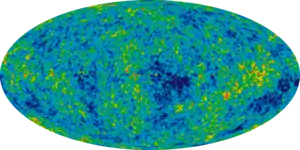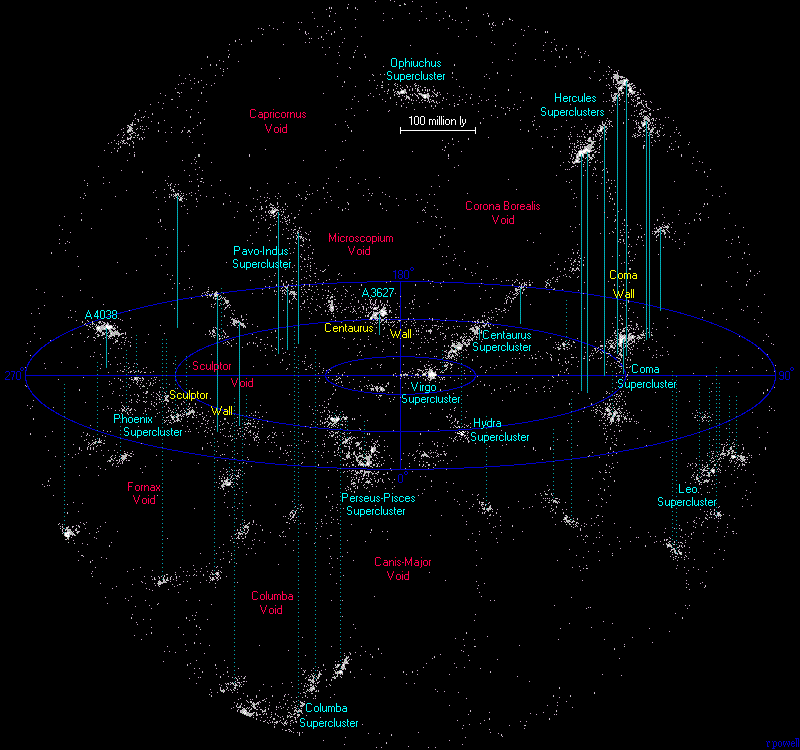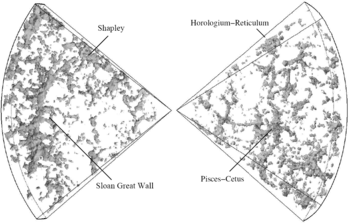Galaxy filament
In physical cosmology, galaxy filaments (subtypes: supercluster complexes, galaxy walls, and galaxy sheets)[1][2] are the largest known structures in the universe. They are massive, thread-like formations, with a typical length of 50 to 80 megaparsecs h−1 (or of the order of 200 to 500 million light-years) that form the boundaries between large voids in the universe.[3] Filaments consist of gravitationally bound galaxies. Parts wherein many galaxies are very close to one another (in cosmic terms) are called superclusters.
| Part of a series on |
| Physical cosmology |
|---|
 |
|
Formation
In the standard model of the evolution of the universe, galactic filaments form along and follow web-like strings of dark matter.[4] It is thought that this dark matter dictates the structure of the Universe on the grandest of scales. Dark matter gravitationally attracts baryonic matter, and it is this "normal" matter that astronomers see forming long, thin walls of super-galactic clusters.
Discovery
Discovery of structures larger than superclusters began in the late-1980s. In 1987, astronomer R. Brent Tully of the University of Hawaii's Institute of Astronomy identified what he called the Pisces–Cetus Supercluster Complex. In 1989, the CfA2 Great Wall was discovered,[5] followed by the Sloan Great Wall in 2003.[6] On January 11, 2013, researchers led by Roger Clowes of the University of Central Lancashire announced the discovery of a large quasar group, the Huge-LQG, which dwarfs previously discovered galaxy filaments in size.[7] In November 2013, using gamma-ray bursts as reference points, astronomers discovered the Hercules–Corona Borealis Great Wall, an extremely huge filament measuring more than 10 billion light-years across.[8][9][10]
Filaments
Filament subtype of filaments have roughly similar major and minor axes in cross-section, along the lengthwise axis.
| Filament | Date | Mean distance | Dimension | Notes |
|---|---|---|---|---|
| Coma Filament | The Coma Supercluster lies within the Coma Filament.[11] It forms part of the CfA2 Great Wall.[12] | |||
| Perseus–Pegasus Filament | 1985 | Connected to the Pisces–Cetus Supercluster, with the Perseus–Pisces Supercluster being a member of the filament.[13] | ||
| Ursa Major Filament | Connected to the CfA Homunculus, a portion of the filament forms a portion of the "leg" of the Homunculus.[14] | |||
| Lynx–Ursa Major Filament (LUM Filament) | 1999 | from 2000 km/s to 8000 km/s in redshift space | Connected to and separate from the Lynx–Ursa Major Supercluster.[14] | |
| z=2.38 filament around protocluster ClG J2143-4423 | 2004 | z=2.38 | 110Mpc | A filament the length of the Great Wall was discovered in 2004. As of 2008, it was still the largest structure beyond redshift 2.[15][16][17][18] |
- A short filament, detected by identifying an alignment of star-forming galaxies, in the neighborhood of the Milky Way and the Local Group was proposed by Adi Zitrin and Noah Brosch.[19] The reality of this filament, and the identification of a similar but shorter filament, were the result of a study by McQuinn et al. (2014) based on distance measurements using the TRGB method.[20]
Galaxy walls
The galaxy wall subtype of filaments have a significantly greater major axis than minor axis in cross-section, along the lengthwise axis.
| Wall | Date | Mean distance | Dimension | Notes |
|---|---|---|---|---|
| CfA2 Great Wall (Coma Wall, Great Wall, Northern Great Wall, Great Northern Wall, CfA Great Wall) | 1989 | z=0.03058 | 251Mpc long
|
This was the first super-large large-scale structure or pseudo-structure in the universe to be discovered. The CfA Homunculus lies at the heart of the Great Wall, and the Coma Supercluster forms most of the homunculus structure. The Coma Cluster lies at the core.[21][22] |
| Sloan Great Wall (SDSS Great Wall) | 2003 | z=0.07804 | 433Mpc long | This was the largest known galaxy filament to be discovered,[21] until it was eclipsed by the Hercules–Corona Borealis Great Wall found ten years later. |
| Sculptor Wall (Southern Great Wall, Great Southern Wall, Southern Wall) | 8000 km/s long 5000 km/s wide 1000 km/s deep (in redshift space dimensions) |
The Sculptor Wall is "parallel" to the Fornax Wall and "perpendicular" to the Grus Wall.[23][24] | ||
| Grus Wall | The Grus Wall is "perpendicular" to the Fornax and Sculptor Walls.[24] | |||
| Fornax Wall | The Fornax Cluster is part of this wall. The wall is "parallel" to the Sculptor Wall and "perpendicular" to the Grus Wall.[23][24] | |||
| Hercules–Corona Borealis Great Wall | 2013 | z≈2[9] | 3 Gpc long,[9] 150 000 km/s deep[9] (in redshift space) |
The largest known structure in the universe.[8][9][10] This is also the first time since 1991 that a galaxy filament/great wall held the record as the largest known structure in the universe. |

- A "Centaurus Great Wall" (or "Fornax Great Wall" or "Virgo Great Wall") has been proposed, which would include the Fornax Wall as a portion of it (visually created by the Zone of Avoidance) along with the Centaurus Supercluster and the Virgo Supercluster also known as our Local Supercluster within which the Milky Way galaxy is located (implying this to be the Local Great Wall).[23][24]
- A wall was proposed to be the physical embodiment of the Great Attractor, with the Norma Cluster as part of it. It is sometimes referred to as the Great Attractor Wall or Norma Wall.[25] This suggestion was superseded by the proposal of a supercluster, Laniakea, that would encompass the Great Attractor, Virgo Supercluster, Hydra-Centaurus Superclusters.[26]
- A wall was proposed in 2000 to lie at z=1.47 in the vicinity of radio galaxy B3 0003+387.[27]
- A wall was proposed in 2000 to lie at z=0.559 in the northern Hubble Deep Field (HDF North).[28][29]
Map of nearest galaxy walls

Large Quasar Groups
Large quasar groups (LQGs) are some of the largest structures known.[30] They are theorized to be protohyperclusters/proto-supercluster-complexes/galaxy filament precursors.[31]
| LQG | Date | Mean distance | Dimension | Notes |
|---|---|---|---|---|
| Clowes–Campusano LQG (U1.28, CCLQG) |
1991 | z=1.28 |
|
It was the largest known structure in the universe from 1991 to 2011, until U1.11's discovery. |
| U1.11 | 2011 | z=1.11 |
|
Was the largest known structure in the universe for a few months, until Huge-LQG's discovery. |
| Huge-LQG | 2012 | z=1.27 |
|
It was the largest structure known in the universe,[30][31] until the discovery of the Hercules–Corona Borealis Great Wall found one year later.[9] |
Supercluster complex
| Name | Date | Mean distance | Dimension | Notes |
|---|---|---|---|---|
| Pisces–Cetus Supercluster Complex | 1987 | 1 billion ly wide, 150 million ly deep |
Contains Virgo Supercluster and Local Group |
Maps of large-scale distribution
 The universe within 1 billion light-years (307 Mpc) of Earth, showing local superclusters forming filaments and voids
The universe within 1 billion light-years (307 Mpc) of Earth, showing local superclusters forming filaments and voids Map of nearest walls, voids and superclusters
Map of nearest walls, voids and superclusters 2dF survey map, containing the SDSS Great Wall
2dF survey map, containing the SDSS Great Wall 2MASS XSC infrared sky map
2MASS XSC infrared sky map
See also
References
- Boris V. Komberg, Andrey V. Kravtsov, Vladimir N. Lukash; "The search and investigation of the Large Groups of Quasars" arXiv:astro-ph/9602090; Bibcode:1996astro.ph..2090K;
- R.G. Clowes; "Large Quasar Groups - A Short Review"; The New Era of Wide Field Astronomy, ASP Conference Series, Vol. 232.; 2001; Astronomical Society of the Pacific; ISBN 1-58381-065-X ; Bibcode:2001ASPC..232..108C
- Bharadwaj, Somnath; Bhavsar, Suketu; Sheth, Jatush V (2004). "The Size of the Longest Filaments in the Universe". Astrophys J. 606 (1): 25–31. arXiv:astro-ph/0311342. Bibcode:2004ApJ...606...25B. doi:10.1086/382140. S2CID 10473973.
- Riordan, Michael; David N. Schramm (March 1991). Shadows of Creation: Dark Matter and the Structure of the Universe. W H Freeman & Co (Sd). ISBN 0-7167-2157-0.
- Huchra, John P.; Geller, Margaret J. (17 November 1989). "M. J. Geller & J. P. Huchra, Science 246, 897 (1989)". Science. 246 (4932): 897–903. doi:10.1126/science.246.4932.897. PMID 17812575. S2CID 31328798. Archived from the original on 2008-06-21. Retrieved 2009-09-18.
- Sky and Telescope, "Refining the Cosmic Recipe" Archived 2012-03-09 at the Wayback Machine, 14 November 2003
- Wall, Mike (2013-01-11). "Largest structure in universe discovered". Fox News. Archived from the original on 2013-01-12. Retrieved 2013-01-12.
- Horvath, Istvan; Hakkila, Jon; Bagoly, Zsolt (2014). "Possible structure in the GRB sky distribution at redshift two". Astronomy & Astrophysics. 561: id.L12. arXiv:1401.0533. Bibcode:2014A&A...561L..12H. doi:10.1051/0004-6361/201323020. S2CID 24224684.
- Horvath I., Hakkila J., and Bagoly Z.; Hakkila, J.; Bagoly, Z. (2013). "The largest structure of the Universe, defined by Gamma-Ray Bursts". 7th Huntsville Gamma-Ray Burst Symposium, GRB 2013: Paper 33 in EConf Proceedings C1304143. 1311: 1104. arXiv:1311.1104. Bibcode:2013arXiv1311.1104H.CS1 maint: multiple names: authors list (link)
- Klotz, Irene (2013-11-19). "Universe's Largest Structure is a Cosmic Conundrum". discovery. Archived from the original on 2013-11-30. Retrieved 2013-11-22.
- 'Astronomy and Astrophysics' (ISSN 0004-6361), vol. 138, no. 1, Sept. 1984, pp. 85-92. Research supported by Cornell University "The Coma/A 1367 filament of galaxies" 09/1984 Bibcode:1984A&A...138...85F
- THE ASTRONOMICAL JOURNAL, 115:1745-1777, 1998 May ; THE STAR FORMATION PROPERTIES OF DISK GALAXIES: Hα IMAGING OF GALAXIES IN THE COMA SUPERCLUSTER
- 'Astrophysical Journal', Part 1 (ISSN 0004-637X), vol. 299, Dec. 1, 1985, p. 5-14. "A possible 300 megaparsec filament of clusters of galaxies in Perseus-Pegasus" 12/1985 Bibcode:1985ApJ...299....5B
- The Astrophysical Journal Supplement Series, Volume 121, Issue 2, pp. 445-472. "Photometric Properties of Kiso Ultraviolet-Excess Galaxies in the Lynx-Ursa Major Region" 04/1999 Bibcode:1999ApJS..121..445T
- NASA, GIANT GALAXY STRING DEFIES MODELS OF HOW UNIVERSE EVOLVED Archived 2008-08-06 at the Wayback Machine, January 7, 2004
- Palunas, Povilas; Teplitz, Harry I.; Francis, Paul J.; Williger, Gerard M.; Woodgate, Bruce E. (2004). "The Distribution of Lyα‐Emitting Galaxies at z = 2.38". The Astrophysical Journal. 602 (2): 545–554. arXiv:astro-ph/0311279. Bibcode:2004ApJ...602..545P. doi:10.1086/381145. S2CID 990891.
- Francis, Paul J.; Palunas, Povilas; Teplitz, Harry I.; Williger, Gerard M.; Woodgate, Bruce E. (2004). "The Distribution of Lyα‐emitting Galaxies at z =2.38. II. Spectroscopy". The Astrophysical Journal. 614 (1): 75–83. arXiv:astro-ph/0406413. Bibcode:2004ApJ...614...75F. doi:10.1086/423417. S2CID 118037575.
- Relativistic Astrophysics Legacy and Cosmology - Einstein's, ESO Astrophysics Symposia, Volume . ISBN 978-3-540-74712-3. Springer-Verlag Berlin Heidelberg, 2008, p. 358 "Ultraviolet-Bright, High-Redshift ULIRGS" 00/2008 Bibcode:2008ralc.conf..358W
- Zitrin, A.; Brosch, N. (2008). "The NGC 672 and 784 galaxy groups: evidence for galaxy formation and growth along a nearby dark matter filament". Monthly Notices of the Royal Astronomical Society. 390 (1): 408–420. arXiv:0808.1789. Bibcode:2008MNRAS.390..408Z. doi:10.1111/j.1365-2966.2008.13786.x. S2CID 16296617.
- McQuinn, K.B.W.; et al. (2014). "Distance Determinations to SHIELD Galaxies from Hubble Space Telescope Imaging". The Astrophysical Journal. 785 (1): 3. arXiv:1402.3723. Bibcode:2014ApJ...785....3M. doi:10.1088/0004-637x/785/1/3. S2CID 118465292.
- Chin. J. Astron. Astrophys. Vol. 6 (2006), No. 1, 35–42 "Super-Large-Scale Structures in the Sloan Digital Sky Survey" (PDF).
- Scientific American, Vol. 280, No. 6, p. 30 - 37 "Mapping the Universe" (PDF). Archived from the original (PDF) on 2008-07-04. (1.43 MB) 06/1999 Bibcode:1999SciAm.280f..30L
- Unveiling large-scale structures behind the Milky Way. Astronomical Society of the Pacific Conference Series, Vol. 67; Proceedings of a workshop at the Observatoire de Paris-Meudon; 18–21 January 1994; San Francisco: Astronomical Society of the Pacific (ASP); c1994; edited by Chantal Balkowski and R. C. Kraan-Korteweg, p.21 ; Visualization of Nearby Large-Scale Structures Archived 2015-11-27 at the Wayback Machine ; Fairall, A. P., Paverd, W. R., & Ashley, R. P. ; 1994ASPC...67...21F
- Astrophysics and Space Science, Volume 230, Issue 1-2, pp. 225-235 "Large-Scale Structures in the Distribution of Galaxies" 08/1995 Bibcode:1995Ap&SS.230..225F
- World Science, Wall of galaxies tugs on ours, astronomers find Archived 2007-10-28 at the Wayback Machine April 19, 2006
- Tully, R. Brent; Courtois, Hélène; Hoffman, Yehuda; Pomarède, Daniel (2 September 2014). "The Laniakea supercluster of galaxies". Nature (published 4 September 2014). 513 (7516): 71–73. arXiv:1409.0880. Bibcode:2014Natur.513...71T. doi:10.1038/nature13674. PMID 25186900. S2CID 205240232.
- The Astronomical Journal, Volume 120, Issue 5, pp. 2331-2337. "B3 0003+387: AGN-Marked Large-Scale Structure at Redshift 1.47?" 11/2000 Bibcode:2000AJ....120.2331T doi:10.1086/316827
- FermiLab, "Astronomers Find Wall of Galaxies Traversing the Hubble Deep Field", DARPA, Monday, January 24, 2000
- Vanden Berk, Daniel E.; Stoughton, Chris; Crotts, Arlin P. S.; Tytler, David; Kirkman, David (2000). "QSO[CLC]s[/CLC] and Absorption-Line Systems surrounding the Hubble Deep Field". The Astronomical Journal. 119 (6): 2571–2582. arXiv:astro-ph/0003203. Bibcode:2000AJ....119.2571V. doi:10.1086/301404. S2CID 117882449.
- ScienceDaily, "Biggest Structure in Universe: Large Quasar Group Is 4 Billion Light Years Across" Archived 2018-08-09 at the Wayback Machine, Royal Astronomical Society, 11 January 2013 (accessed 13 January 2013)
- Clowes, Roger G.; Harris, Kathryn A.; Raghunathan, Srinivasan; Campusano, Luis E.; Soechting, Ilona K.; Graham, Matthew J.; "A structure in the early universe at z ~ 1.3 that exceeds the homogeneity scale of the R-W concordance cosmology"; arXiv:1211.6256 ; Bibcode:2012arXiv1211.6256C ; doi:10.1093/mnras/sts497 ; Monthly Notices of the Royal Astronomical Society, 11 January 2013
Further reading
- Kevin A. Pimbblet, "Pulling Out Threads from the Cosmic Tapestry: Defining Filaments of Galaxies" (PDF)., arXiv, 14 March 2005.